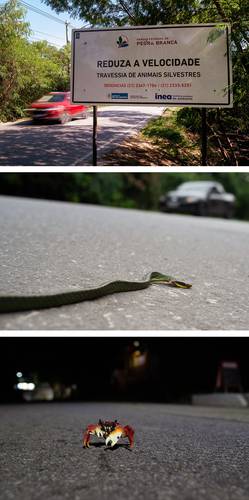Rio de Janeiro. Attention, tapir on the near perimeter of the road. An application project for drivers aims to reduce wildlife collisions in Brazil through artificial intelligence (AI) technology, the main threat to several vulnerable species.
In Brazil, 475 million animals die each year crushed or rammed on roads, according to calculations by the Brazilian Center for Studies in Road Ecology (CBEE) of the Federal University of Lavras, in the state of Minas Gerais (southeast).
That figure only counts vertebrate animals, from birds and frogs to mammals. The capybara, the armadillo and the opossum are among the most punished.
In between 15 and 17 animals are hit by cars every second on our roads. It is the largest direct impact on the fauna that exists today in Brazil.
maintains the CBEE coordinator, Alex Bager.
Concerned about this reality, Gabriel Souto Ferrante, a student of the master’s degree in cybernetic sciences at the University of Sao Paulo (USP), has been developing since 2021 a system based on computer vision to detect species and alert of their presence on the route.
The project, carried out in conjunction with the Institute of Mathematical and Computer Sciences of USP, was published in January by the magazine Scientific Reports.
From the puma to the yaguarundi
Souto identified the five medium- and large-sized species that most perish when run over on the vast road network of the most megadiverse country in the world.
They are the puma, the giant anteater or palm bear, the tapir, the maned wolf and the jaguarundi, all of which are threatened with extinction.
He created a database with thousands of photos to train his AI model.
Extensive testing followed with a high-precision real-time object detection algorithm, called YOLO. And finally, the examinations with images of the animals monitored in movement, which were successful, according to the researcher.
However, more tests are needed to implement this technology in practice. But, above all, support from companies that manage roads
Souto pointed out.
Access to cameras on the routes and safety equipment is necessary. edge computing
(edge computingprocessing at the origin itself or in the vicinity of the data generation) to send the warning signal to the driver and also to the concessionaire company, in order for them to “take care of the removal or capture of the animal.”
The technology would also improve safety for humans, who are also often victims of accidents due to animal crossings.
Vegetable runners
To minimize the effect of habitat fragmentation due to roads, various strategies have been implemented in Brazil, Bager explained to Afp.
Traditional road signs warning of the possible presence of animals do not persuade drivers, who reduce their speed by just 3 percent when they see the signs.
There are so-called ecological corridors and green bridges, which can be underpasses (to cross under the tracks) or elevated walkways, sometimes covered with vegetation, logs and ropes to encourage animals to pass through them.
Underpasses are the most widespread mitigation measure in Brazil today. There are also two vegetated overpasses, one in Rio de Janeiro for the golden lion tamarin and another in Sao Paulo.
Bager explained.
But this infrastructure is insufficient and its impact is minimal in a country of gigantic territorial size.
In 2014, the expert created the Urubú System, a citizen science social network
which had more than 50 thousand people reporting cases of wild fauna being attacked throughout the Brazilian territory.
The information collected helped create public policies and even a bill to guarantee the safe movement of animals, which is still awaiting a vote in Congress, he said.
But a lack of financial resources forced him to suspend the platform last year. However, Bager does not give up and insists on efforts to reactivate it.
We have more and more roads, more vehicles and a number of roadkill that probably continues to grow.
lament.
